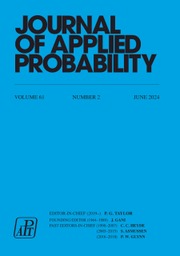No CrossRef data available.
Article contents
Long edges in Galton–Watson trees
Part of:
Markov processes
Published online by Cambridge University Press: 18 February 2025
Abstract
We establish a number of results concerning the limiting behaviour of the longest edges in the genealogical tree generated by a continuous-time Galton–Watson process. Separately, we consider the large-time behaviour of the longest pendant edges, the longest (strictly) interior edges, and the longest of all the edges. These results extend the special case of long pendant edges of birth–death processes established in Bocharov et al. (2023).
MSC classification
Secondary:
60J85: Applications of branching processes
- Type
- Original Article
- Information
- Copyright
- © The Author(s), 2025. Published by Cambridge University Press on behalf of Applied Probability Trust
References
Bocharov, S., Harris, S. C., Kominek, E., Mooers, A. and Steel, M. (2023). Predicting long pendant edges in model phylogenies with applications to biodiversity and tree inference. Syst. Biol. 72, 575–589.CrossRefGoogle ScholarPubMed
Disanto, F. and Fuchs, M. (2023). Distribution of external branch lengths in Yule histories.Electron. J. Combinatorics 30, P3.23.Google Scholar
Gascuel, O. and Steel, M. (2010). Inferring ancestral sequences in taxon-rich phylogenies. Math. Biosci. 227, 125–135.CrossRefGoogle ScholarPubMed
Haccou, P., Jagers, P. and Vatutin, V. A. (2005). Branching Processes: Variation, Growth and Extinction of Populations, Cambridge University Press.CrossRefGoogle Scholar
Jagers, P. and Nerman, O. (1984). The growth and composition of branching populations. Adv. Appl. Prob. 16, 221–259.CrossRefGoogle Scholar
Olofsson, P. (1998). The
 $x \log x$
condition for general branching processes. J. Appl. Prob. 35, 537–544.CrossRefGoogle Scholar
$x \log x$
condition for general branching processes. J. Appl. Prob. 35, 537–544.CrossRefGoogle Scholar



